 The Howard Electric Novelty Company of New York, later the Howard Miniature Lamp Co. of East Orange, New Jersey
(invented electric Christmas tree lights), produced an amazing amount of toy train equipment between 1904 and 1906.
The company was founded in 1904 by Harvey Wilson Harper and brothers Herbert E. and Herbert C. Plass. The company name
was derived from the street in Manhattan where it was initially located - Howard Street. No other 2 inch
2 rail company introduced so many models within so short a period. It is ironic that the company ceased
all train production 5 years later in 1911 in order to concentrate on production of bulbs and radio tubes.
The Howard Electric Novelty Company of New York, later the Howard Miniature Lamp Co. of East Orange, New Jersey
(invented electric Christmas tree lights), produced an amazing amount of toy train equipment between 1904 and 1906.
The company was founded in 1904 by Harvey Wilson Harper and brothers Herbert E. and Herbert C. Plass. The company name
was derived from the street in Manhattan where it was initially located - Howard Street. No other 2 inch
2 rail company introduced so many models within so short a period. It is ironic that the company ceased
all train production 5 years later in 1911 in order to concentrate on production of bulbs and radio tubes.
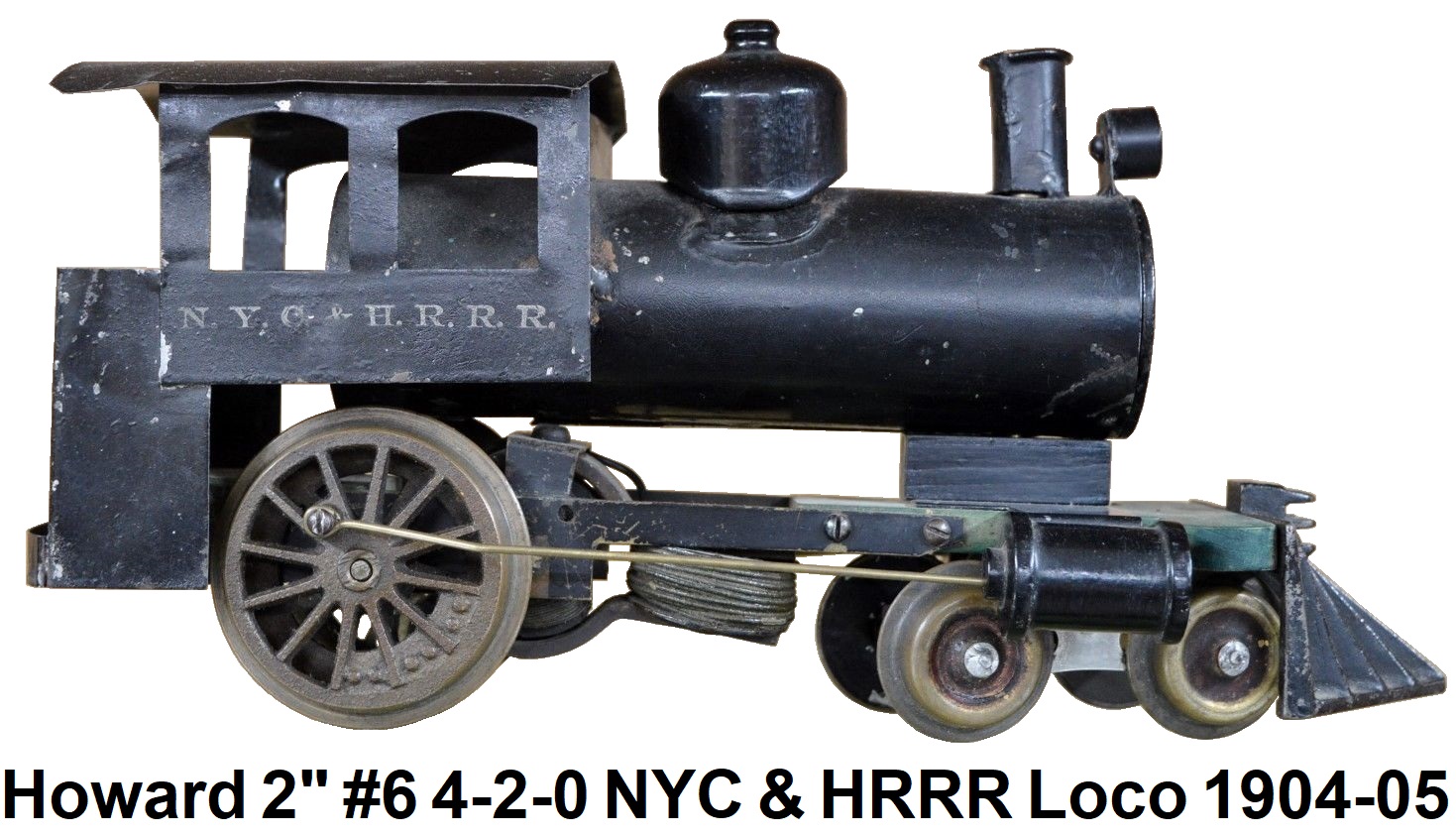 Howard Trains paralleled Carlisle & Finch
in the general construction of their
train equipment, that is to say they were more like C. & F. than the other 2 inch 2 rail manufacturers
of the era - Voltamp or Knapp. You might say that Howard
was the most considerate of all the early manufacturers for they were the only company that manufactured
their cars with more than one type of coupler. To satisfy boys who already owned C. & F. equipment but
contemplated buying Howard rolling stock, they produced some cars with the C. & F. curved metal band
couplers. Some cars were made with both the Howard link & pin or hook plus the C. & F. band couplers.
Voltamp couplers are never found except on Voltamp equipment (unless converted by an individual)
therefore Howard must not have felt their equipment was as compatible with them as with C. & F.
Howard Trains paralleled Carlisle & Finch
in the general construction of their
train equipment, that is to say they were more like C. & F. than the other 2 inch 2 rail manufacturers
of the era - Voltamp or Knapp. You might say that Howard
was the most considerate of all the early manufacturers for they were the only company that manufactured
their cars with more than one type of coupler. To satisfy boys who already owned C. & F. equipment but
contemplated buying Howard rolling stock, they produced some cars with the C. & F. curved metal band
couplers. Some cars were made with both the Howard link & pin or hook plus the C. & F. band couplers.
Voltamp couplers are never found except on Voltamp equipment (unless converted by an individual)
therefore Howard must not have felt their equipment was as compatible with them as with C. & F.
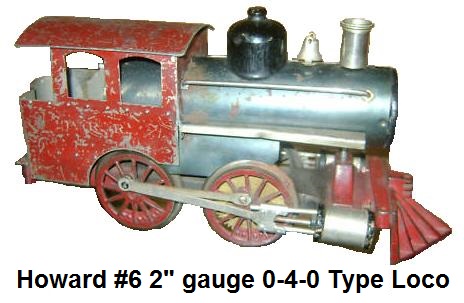
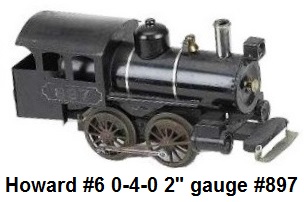
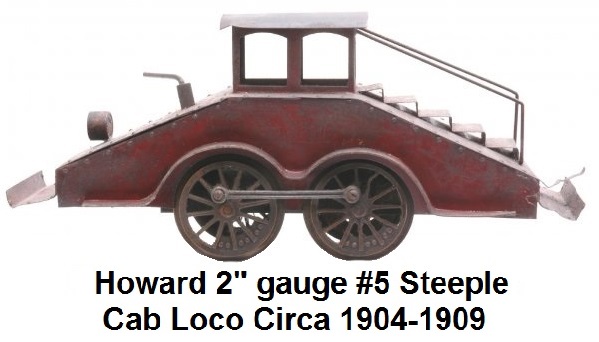 Howard issued only one electric outline loco - a #5 0-4-0 Steeple Cab, which they referred to in their
catalogs as a Mining Loco. It was 12" long, had a dummy headlight,
a reverse mechanism, and was numbered 897. It sold for $4.50. Steam Locomotive models started
with the #6 Switcher type which
had several styles. The earliest was a small 4-2-0 with no markings and a wood frame. Later
came another 4-2-0 that was slightly larger, at 10" long, with all metal frame construction, a reversing
mechanism, and a Russian Iron boiler. Finally, a #6 0-4-0 was issued. It was 11" long and included a
reversing mechanism. All #6's included a coal bunker,
similar to Lionel's #5. The #8 steam loco was a 4-4-0 with an 8 wheel tender. It
was an almost scale model that included details such as nickel trim, reverse lever in the cab,
a dummy headlight, air compressor and air lines, handrails, foot walks, nickel bands, and rivet details
on the boiler. The engine also had 2½" bronze drive wheels, and die cast side and main rods. Length of
the locomotive with tender was 21", and it sold for $10 without track.
Howard issued only one electric outline loco - a #5 0-4-0 Steeple Cab, which they referred to in their
catalogs as a Mining Loco. It was 12" long, had a dummy headlight,
a reverse mechanism, and was numbered 897. It sold for $4.50. Steam Locomotive models started
with the #6 Switcher type which
had several styles. The earliest was a small 4-2-0 with no markings and a wood frame. Later
came another 4-2-0 that was slightly larger, at 10" long, with all metal frame construction, a reversing
mechanism, and a Russian Iron boiler. Finally, a #6 0-4-0 was issued. It was 11" long and included a
reversing mechanism. All #6's included a coal bunker,
similar to Lionel's #5. The #8 steam loco was a 4-4-0 with an 8 wheel tender. It
was an almost scale model that included details such as nickel trim, reverse lever in the cab,
a dummy headlight, air compressor and air lines, handrails, foot walks, nickel bands, and rivet details
on the boiler. The engine also had 2½" bronze drive wheels, and die cast side and main rods. Length of
the locomotive with tender was 21", and it sold for $10 without track.

 In 1906 Howard introduced their deluxe #10, 4-4-0 locomotive, somewhat larger than the #8 at 23" long, finished
in nickel and brass with Russian iron boiler. This model incorporated the first operating headlight
ever used on toy electric trains. The Tender was nickel plated complete with imitation coal, tool
box and brake wheel, and the letters 'NYC&HRR' were stamped on the side. It sold for $20.00.
Even more rare than this #10 was the most scarce of all
2 inch 2-rail locos. It was even larger than the catalogued #10, but was exactly the same to all
outward appearances. One special feature was a movable headlight which was operable from a lever in the Cab.
It could be moved from side to side, so the Howard engineer could follow the curve of the track in front of
him.
In 1906 Howard introduced their deluxe #10, 4-4-0 locomotive, somewhat larger than the #8 at 23" long, finished
in nickel and brass with Russian iron boiler. This model incorporated the first operating headlight
ever used on toy electric trains. The Tender was nickel plated complete with imitation coal, tool
box and brake wheel, and the letters 'NYC&HRR' were stamped on the side. It sold for $20.00.
Even more rare than this #10 was the most scarce of all
2 inch 2-rail locos. It was even larger than the catalogued #10, but was exactly the same to all
outward appearances. One special feature was a movable headlight which was operable from a lever in the Cab.
It could be moved from side to side, so the Howard engineer could follow the curve of the track in front of
him.
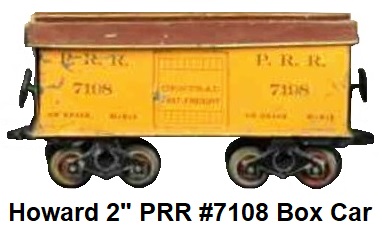 Howard made 4 different 4 wheel street cars. The first type was 7½" long, had
a removable body with 4 windows, leaving a motorized flat car when removed, and was lettered 'Electric RR'.
It had no reversing mechanism, and a two pole armature. The second trolley car was 12 inches long
had interior seats, a reversing mechanism, was marked 'Electric Traction Line', and numbered 459.
The third was more of a motorized gondola similar to a Lionel 2 7/8" gauge model, was 9" long,
and was lettered 'Express'. A fourth type trolley was the same as the third type but came with a 6 window
body slipped over it. Lettering was also 'Electric Traction Line'.
Howard made 4 different 4 wheel street cars. The first type was 7½" long, had
a removable body with 4 windows, leaving a motorized flat car when removed, and was lettered 'Electric RR'.
It had no reversing mechanism, and a two pole armature. The second trolley car was 12 inches long
had interior seats, a reversing mechanism, was marked 'Electric Traction Line', and numbered 459.
The third was more of a motorized gondola similar to a Lionel 2 7/8" gauge model, was 9" long,
and was lettered 'Express'. A fourth type trolley was the same as the third type but came with a 6 window
body slipped over it. Lettering was also 'Electric Traction Line'.

Freight cars were catalogued as 'trailers' and included a #20 Flat car, a #21 Gondola,
a #24 Boxcar, a #25 Caboose, a #26 Dump car, and a #27 Oil car. These were all double truck
8 wheel cars, except for the dump car which was a 4 wheel model. They were all 10" in length.

Passenger cars came in two sizes. They included a #22 12" Coach, #23 12" Baggage car,
#28 15" Baggage car, a #29 15" Pullman chair car, and a #30 15" Pullman palace car. The 15" cars had
open platforms, except for the sleeper which had vestibules, was lettered 'Pennsylvania', 'FFV', and
'Limited', and under the windows 'Adair'. All had stamped frames, and cast iron wheels, insulated at the
hub with wood sleeves for two rail operation. The 15" Coach and sleeper had removable roofs and some
interior fittings. Seats had reversible backs similar to oldtime day coaches on the real railroads.



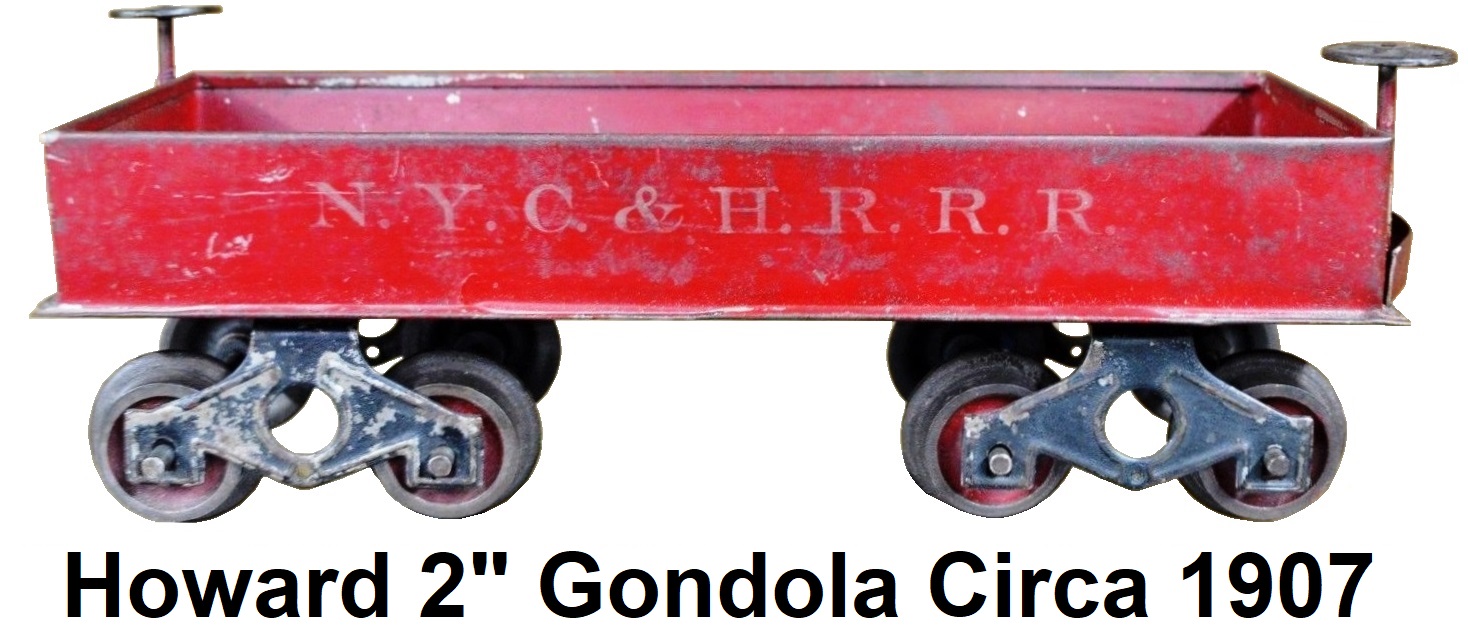 In 1904 the Plass brothers operated the Howard Electric Novelty Company, the electric Supply company,
and the Savonoid Manufacturing Company, all in New York City (Trow's Greater New York Business Directory 1902). In 1904
Harper had received a patent for a "Machine for Making Incandescent-Electric-Lamp Bulbs," an apparatus that represented a
significant improvement in the production of these bulbs. An immigrant from England (he would be naturalized in 1943),
Harper had been working with miniature lamps (mainly for Christmas decorations, candelabras, telephone switchboards, and
flashlights) since 1897. He learned on the job, and by 1900 headed the miniature lamp department for his employer, General
Electric. In 1907, the Howard Miniature Lamp Company moved to 327 Academy Street in Newark, then relocated to 338 Main
Street in East Orange, NJ by 1914. Around this time the company began making automobile headlight incandescent bulbs as
replacements for the gas and oil lights previously used on vehicles, soon achieving a leading position in this business.
The company relocated one more time to Springfield Ave. and 19th Street in East Orange in 1915. Harper was
forced to sell the company to General Electric in 1916 to avoid that firm 's threat of a patent infringement lawsuit.
In 1904 the Plass brothers operated the Howard Electric Novelty Company, the electric Supply company,
and the Savonoid Manufacturing Company, all in New York City (Trow's Greater New York Business Directory 1902). In 1904
Harper had received a patent for a "Machine for Making Incandescent-Electric-Lamp Bulbs," an apparatus that represented a
significant improvement in the production of these bulbs. An immigrant from England (he would be naturalized in 1943),
Harper had been working with miniature lamps (mainly for Christmas decorations, candelabras, telephone switchboards, and
flashlights) since 1897. He learned on the job, and by 1900 headed the miniature lamp department for his employer, General
Electric. In 1907, the Howard Miniature Lamp Company moved to 327 Academy Street in Newark, then relocated to 338 Main
Street in East Orange, NJ by 1914. Around this time the company began making automobile headlight incandescent bulbs as
replacements for the gas and oil lights previously used on vehicles, soon achieving a leading position in this business.
The company relocated one more time to Springfield Ave. and 19th Street in East Orange in 1915. Harper was
forced to sell the company to General Electric in 1916 to avoid that firm 's threat of a patent infringement lawsuit.
